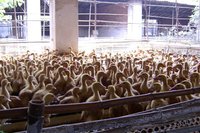
Updates on the Avian Flu, and Will It Foster Changes in China’s Animal Farming System?

Birds in China
It has been a month since the first case of the human-infected influenza A (H7N9) was reported. By May 1st, the virus had been diagnosed in 128 people and has killed 27 people since March. Recently, a booklet called Don’t be Scared of Birds was published in China to inform the public about influenza A (H7N9) and how to protect themselves from it, although many details of the virus remain unknown.
The Virus, a Slippery One
It has been agreed that the virus has an avian origin, and that some of the patients have had direct contact with live poultry or have been exposed to bird feces, but the mechanism of transmission is not clear yet, nor is it confirmed whether the virus can spread directly from bird to human or between humans.
Phylogenetic studies revealed that the genome of the novel H7N9 virus is a combination of at least three virus strains from four different origins, instead of a direct mutant from the classical H7N9. The finding of an asymptomatic carrier in Beijing on April 14 might be evidence that the virus is still evolving to adapt to humans.
During the process of evolution, the virus may become more or less lethal; a human-to-human transmission pathway may also be established. In general, lower lethality favors the survival of the virus because the host, on which the virus relies to replicate, is not killed.
However, because the mutations that change the lethality and transmission pattern of the virus take place on a highly random basis, researchers call for an “extensive global surveillance” to spot any sign of a more virulent or more transmissible virus strain as early as possible.
Cross infection between birds (as well as other animals) can make it easier for the virus to evolve. To prevent this, farmers were asked to avoid raising different animals together and to mark birds in live poultry markets to allow source tracking. But one thing special about the novel H7N9 virus is that it does not cause severe symptoms in or massive death of birds. This renders it more difficult to monitor and to control the spread of the virus among possible host groups, even in a well-traceable system.
However, some residents are not aware of the risk if this “invisible” virus – in Maoming, Guangdong Province, the price of poultry plunged and led to a flash sale. Nearby villages saw trucks of live chicken sold cheaply. One customer said, “(I am) not scared (of the avian flu) at all. Feed the birds for several months…and it should be ok (to consume them).” It seems the booklet hasn’t reached the areas where the necessary information is most needed.
To Industrialize or not to Industrialize
As there are calls for a ban on live poultry markets, some say that intensifying and industrializing the poultry farming system is a more effective way to ensure food safety. If the poultry comes from a few large farms rather than numerous small farms, the number of quarantine tests can be reduced. Standardized production may also control the use of antibiotics and antiviral drugs, where drug overuse on animals may increase drug resistance in the pathogen population.
An industrialized system might be more cost-effective and easier to regulate, but such a system is not as healthy as it sounds. In factory farms, tightly packed animals and the desire for faster growth give the farmers more reasons to use antibiotics and other chemicals.
In terms of preventing diseases, small-scale family farming possesses intrinsic advantages: more attention on each animal. Instead of merging small farms into larger ones, organizing the existing family farms and enhancing the education system in rural areas, with services to teach farmers about sustainable farming techniques, might be a more urgent task with long-term benefit.
The outbreak of influenza A (H7N9) has again drawn public attention to China’s farming and food system, which is highly dispersed and loosely organized. How to better manage the country’s family farming system, and equip it with quality control mechanisms such as health check and source tracking, remains a huge challenge.
Photo courtesy of Peter Li/Humane Society International/Compassion and World Farming
 Brighter Green
Brighter Green



